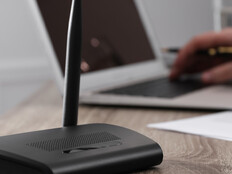What Is Wi-Fi 6E?
In April, the Federal Communications Commission adopted a proposal that opens the 6GHz band for unlicensed Wi-Fi. By doing so, the agency freed up 1,200 megahertz of wireless spectrum for Wi-Fi use, a massive increase in potential bandwidth.
As CNET notes, “to put that in perspective, the 2.4GHz band, one of the two already allocated for Wi-Fi, offers just 70MHz of bandwidth.”
“To accommodate that increase in Wi-Fi demand, the FCC is aiming to increase the supply of Wi-Fi spectrum with our boldest initiative yet: making the entire 6GHz band available for unlicensed use,” the FCC stated in its announcement. “By doing this, we would effectively increase the amount of spectrum available for Wi-Fi almost by a factor of five.”
Wi-Fi 6E operates in the 6GHz band as well as the 2.4GHz and 5GHz bands that Wi-Fi 6 uses. In fact, the main difference is the addition of that 6GHz band.
“Even without diving into additional features, more spectrum equals more channels, which means less likelihood of interference from other Wi-Fi devices,” Colin Vallance, a wireless technical architect at CDW, writes in a blog post.
“This is an oversimplification, but I cannot stress enough how impactful the additional band will be overall,” Vallance adds. “Unlike some other standards, such as 802.11ad, which was not widely adopted, I predict the industry will rapidly adopt Wi-Fi 6E in order to leverage this nearly greenfield space.”
EXPLORE: How will 5G impact smart cities?
Wi-Fi 6 vs. Wi-Fi 6E: What’s the Difference?
Wi-Fi 6 brought with it several new features to increase wireless performance compared with Wi-Fi 5. Those include orthogonal frequency-division multiplexing access, which enables routers and devices to use bandwidth more efficiently; target wait time, which reduces power consumption and saves device battery life; and increased speed and range.
As wireless vendor Netgear notes in a post on its site, Wi-Fi 6E builds on these features and includes support for up to 14 80MHz channels or seven 160 MHz channels. More available channels mean more available spectrum for Wi-Fi service “and less overlap between networks in crowded areas like apartment complexes or offices,” the company notes.
As CNET reports: “In layman’s terms, if the 2.4GHz band is a one-lane country highway and the 5GHz band is a three-lane interstate, picture the 6GHz band as a shiny, new seven-lane superhighway, and only 6E devices get access to the onramp.”
Another technical difference between Wi-Fi 6 and Wi-Fi 6E is that 6E does not require dynamic frequency selection channels. “Unlike 160MHz channels in the 5GHz wireless band, devices operating in 6GHz don’t share the spectrum with radar devices or TV stations,” according to Netgear. “As a result, people who cannot take advantage of 160MHz channels because they live near places like airports or TV stations can benefit from vacant 160MHz channels.”
RELATED: Follow these tips when building public Wi-Fi networks.
Wi-Fi 6E also has mandatory Wi-Fi Protected Access 3 security controls, which is the highest Wi-Fi Alliance security certification. “WPA3 provides the latest in security and authentication protocols. As a result, 6GHz Wi-Fi traffic is more secure than ever, and 6GHz networks are more difficult to hack,” Neatgear states.
Yet another benefit of Wi-Fi 6E is that it operates differently in terms of power limitations. “Typically, faster Wi-Fi is directly related to utilizing wider channels, and with the added spectrum it’s likely we’ll see greater adoption of 40MHz and 80MHz channels,” Vallance adds. “With Wi-Fi 6 and earlier, one of the major issues with wider channels — aside from limited spectrum — is that doubling the channel bandwidth also doubles the noise floor. In dense environments, this becomes very problematic as the client now needs to overcome the additional noise floor in order to have effective communication with the access point.”
However, Vallance writes, “this is where 6E shines with the addition of power spectral density, which allows for increased power limits as channel widths increase. Because the power increase can now keep up with the noise floor, this feature removes the noise stigma from using wider channels.”
The Benefits of Wi-Fi 6E
**The major benefit of Wi-Fi 6E is that it has the potential to deliver faster speeds more consistently thanks to how much spectrum Wi-Fi 6E devices can access.
“The most impactful difference is that Wi-Fi 6E devices use a dedicated 6E spectrum with up to seven additional 160 MHz channels while Wi-Fi 6 devices share the same congested spectrum — and only two 160 MHz channels — with other legacy Wi-Fi 4, 5, and 6 devices,” according to Intel’s website. “This gives Wi-Fi 6E devices the advantage and ability to experience gigabit speeds more easily. Wi-Fi 6 devices will not be able to take advantage of the benefits of the 6 GHz spectrum used by Wi-Fi 6E.”
Those characteristics enable easier use of more bandwidth-intensive applications. “More available high-bandwidth channels means more capacity for applications like 4K and 8K streaming, virtual reality gaming, and high-definition video conferencing,” Netgear notes.
“Wi-Fi 6E will open up hundreds of channels, versus the 24 available now, increasing throughput tremendously,” Jay Myers, a wireless solution architect at CDW, writes in a blog post. “This will essentially take a two-lane country road and make it a four-lane highway.”
An important factor for IT decision-makers to be aware of is that Wi-Fi 6E will not be backward compatible, as most Wi-Fi generations have been, Myers says. “Some vendors are considering chipsets that will work with both old and new access points, but we’ll still have to navigate the power requirements associated with those APs,” he adds.
Also, Vallance notes, “6E will support 802.11ax only and drop 802.11a/b/g/n/ac devices entirely.” He frames that as a benefit “because the previous requirement to be backward compatible with former generations has often hampered new efficiencies.”
“A slightly dated but well-known example is that any clients that still require 802.11b will slow down the network significantly due to the modulation change and greater time on air,” he writes. “Without these shackles, 6E will have little problem leveraging OFDMA and other capabilities that come with Wi-Fi 6 (802.11ax).”
Myers writes that, “from an IT perspective, it’s time to make the move,” adding that Wi-Fi 6E “promises to be even more of a game changer than Wi-Fi 6.”











